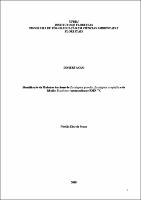| ???jsp.display-item.social.title??? |


|
Please use this identifier to cite or link to this item:
https://tede.ufrrj.br/jspui/handle/tede/456| ???metadata.dc.type???: | Dissertação |
| Title: | Identificação de madeiras de clones de Eucalyptus grandis, Eucalyptus urophylla e do híbrido Eucalyptus urograndis por RMN 13C |
| Other Titles: | Wood identification of clones of Eucalyptus grandis, Eucalyptus urophylla and of the hybrid Eucalyptus urograndis by 13C NMR |
| ???metadata.dc.creator???: | Souza, Natalia Dias de  |
| ???metadata.dc.contributor.advisor1???: | Abreu, Heber dos Santos |
| ???metadata.dc.description.resumo???: | O gênero Eucalyptus é representado por árvores com alta taxa de crescimento, plasticidade, forma retilínea de crescimento do fuste, desrama natural e madeira com variações nas propriedades tecnológicas, adaptadas às mais variadas condições de uso. Em função das pressões ecológicas e da distância do mercado consumidor de madeiras nativas, o eucalipto apresenta-se como uma das melhores opções para suprir este mercado no Brasil. O eucalipto pode apresentar características anatômicas e morfológicas muito parecidas, principalmente em decorrência de cruzamento natural, tornando-se extremamente difícil a sua identificação. As técnicas conhecidas da sistemática botânica e da anatomia da madeira muitas vezes exigem ferramentas indisponíveis. A Ressonância Magnética Nuclear (RMN) sem dúvida pode vir a ser uma das mais promissoras técnicas de identificação, haja vista os estudos de estruturas e da dinâmica de moléculas orgânicas em solução. A RMN permite elucidar as estruturas moleculares de várias substâncias incluindo as que ocorrem na madeira. Esta pesquisa teve o objetivo de constituir um método de identificar as madeiras de espécies do gênero Eucalyptus através da técnica de RMN 13C utilizando as variações espectrais dos extratos ciclohexânicos sob o ponto de vista fisiológico, ecológico e genético. Com os resultados obtidos, pode-se concluir que os espectros dos extratos ciclohexânicos do cerne foram os mais representativos para o estudo de identificação de madeiras, devido ao número de sinais existentes em relação às regiões dos espectros: alifática (0 a 55 ppm), olefínicas e aromáticas (110 a 155 ppm) e carbonílicas e acílicas (155 a 220 ppm). Com esses resultados foi possível identificar o perfil espectral comum para as espécies E. grandis e E. urophylla e para o híbrido E. urograndis de cada região anatômica (alburno, zona de transição e cerne). |
| Abstract: | The Eucalyptus genus is represented for trees that have high growth rate, plasticity, straight way of stem growth, natural pruning and wood with the technological properties suitable for a diverse use. In function of ecological society pressure and the larger distance between the forest and the consumer center, the native woods have been substituted by eucalyptus wood, which presents enough condition and great options to supply the necessity and the exigent wood market in Brazil. In this context, many researches on Eucalyptus have been carried on several point of view. One of difficulty for usury of Eucalyptus wood is its identification. For solve this problem, it was developed an alternative way for Eucalyptus wood identification, without to take hand the anatomical and morphological tools. Thus new methods of identification faster and cheaper must be developed. On this way, the application of Nuclear Magnetic Resonance (NMR) showed to be one promise technique for wood identification. This research has turned possible with NMR 13C spectrometry method. A spectral variation among cyclohexane extracts permitted to observe the physiological, ecological and genetical behavior on the Eucalyptus wood. Dada of 13C NMR has shown that the cyclohexane extracts spectra of heartwood were the most representative for the wood identification, than others solvent. With these data was possible to establish a common spectral profile for E. grandis, E. urophylla and E. urograndis from each anatomical wood region (sapwood, transition zone and heartwood). |
| Keywords: | identificação de madeiras extratos perfil espectral RMN 13C wood identification extracts spectral profile |
| ???metadata.dc.subject.cnpq???: | Recursos Florestais e Engenharia Florestal |
| Language: | por |
| ???metadata.dc.publisher.country???: | Brasil |
| Publisher: | Universidade Federal Rural do Rio de Janeiro |
| ???metadata.dc.publisher.initials???: | UFRRJ |
| ???metadata.dc.publisher.department???: | Instituto de Florestas |
| ???metadata.dc.publisher.program???: | Programa de Pós-Graduação em Ciências Ambientais e Florestais |
| Citation: | SOUZA, Natalia Dias de. Identificação de madeiras de clones de Eucalyptus grandis, Eucalyptus urophylla e do híbrido Eucalyptus urograndis por RMN 13C. 2008. 199 f. Dissertação (Mestrado em Ciências Ambientais e Florestais) - Instituto de Florestas, Universidade Federal Rural do Rio de Janeiro, Seropédica - RJ, 2008. |
| ???metadata.dc.rights???: | Acesso Aberto |
| URI: | https://tede.ufrrj.br/jspui/handle/tede/456 |
| Issue Date: | 7-Mar-2008 |
| Appears in Collections: | Mestrado em Ciências Ambientais e Florestais |
Files in This Item:
| File | Description | Size | Format | |
|---|---|---|---|---|
| 2008 - Natália Dias de Souza.pdf | 2.42 MB | Adobe PDF |  Download/Open Preview |
Items in DSpace are protected by copyright, with all rights reserved, unless otherwise indicated.




